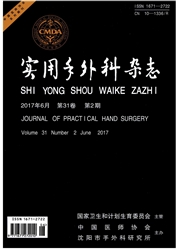

 中文摘要:
中文摘要:
目的观察去细胞同种异体神经体内移植后组织形态学改变,寻找合适的人工神经支架材料。方法共使用成年猕猴9只,随机取其中的6只,培养自体Scs,应用已经制备好的去细胞神经为支架材料,体外构建组织工程化周围神经移植体修复猕猴尺神经40mm缺损。分实验组、空白组、正常对照组3组。术后5个月取材,观察大体形态、HE染色、免疫组织化学染色及组织形态学改变。结果3组移植物表面均有不同程度的血管化,HE染色均有细胞核和髓鞘的蓝染成份出现,NF免疫组织化学染色后,均有淡黄色神经微丝出现。实验组、正常对照组效果相似,它们均优于空白组、实验组,正常对照组再生神经纤维的数量差异均无统计学意义(P〉0.05)。但在实验组与空白组间的差异有统计学意义(P〈0.05)。结论去细胞同种异体神经具有良好的生物相容性和促进神经再生能力,是最具应用前景的神经修复材料之一。
 英文摘要:
英文摘要:
Objective To examinate the histological change of chemically extracted acellular nerve allografts(ANG) in vivo and then to find proper tissue-engineered scaffolds. Methods 18 ulnar nerve defect of 9 rhesus were divided into three groups randomly, 6 rhesus of them also were used to culture Schwann ceUs(Scs). Then Scs were implanted into ANG to fabricate tissue-engineered nerve to repair a 40mm defect model of adult rhesus ulnar nerves: using ANG microinjected with Scs in experiment group, using ANG without Scs in blank group, using the autografts in normal control group, Five months postoperatively examined by morphology, HEstain,neurofilament immunohistochemistry stain. Results No ulcer can be seen on the monkeys' hands. Brevis have no significant differences among the three groups Five months postoperatively, the number of neurofilament in experiment group and normal control group was not statistically significant(P 〉0.05) ; but the different in experiment group and in blank group was statistically significant(P 〈0.05) Conclusion ANG is the most promised materials to repair nerve defects because of its biocompatibility and inductive ability to nerve regenerate.
 同期刊论文项目
同期刊论文项目
 同项目期刊论文
同项目期刊论文
 期刊信息
期刊信息
